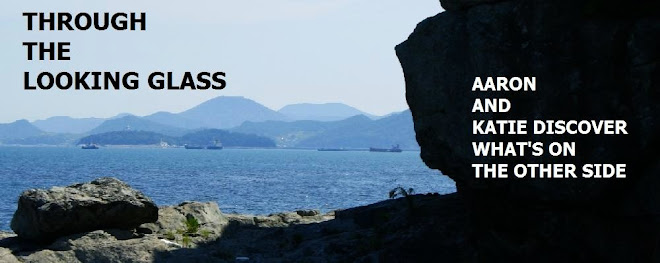
Over the weekend, Katie and I took a trip to Yeosu with Henry and Nancy. Yeosu is about 100 miles east of Changwon, and is Henry's old college town. We arrived Saturday morning and stayed until Sunday afternoon.

When we arrived, we met one of Henry's university friends for lunch at a Chinese restaurant.

Korean Chinese food is quite different than American Chinese food. We ate deep-fried pork, smothered in a sweet sauce, and rice with a fried egg on top. There was also the obligatory kimchi and other Korean side dishes. If you're wondering what is accompanying the rice on my plate, it is a small pile of shredded cabbage with a healthy dollop of ketchup on it. Koreans seem to think of this as an exotic garnishment, as I've seen it served with a variety of "foreign" foods.

Yeosu is famous for, among other things, a full-scale, functional reproduction of a turtle ship (Geobukseon in Korean). Admiral Yi used turtle ships, the world's first iron-clad battle ships, to defeat the Japanese navy when they invaded in 1592.

On Saturday afternoon we decided to visit the Hyang-Ir-Am temple. The temple is located at the top of a low coastal mountain called Mt. Geumo, and was established in A.D. 659. At the base of the mountain, a short peninsula extends into the sea. The Koreans have always believed that this natural formation looks like a giant turtle crawling toward the ocean; thus, the temple is located on the turtle's back. In this photo you can distinguish the turtle's shell on the right and its head extending to the left.

On our way toward the base of the mountain we passed this interesting looking house, which I think is used as a seaside lodge.

We spotted this enormous spider along the way. It's a shame you can't tell just how large it was by looking at the picture. I'd say it was at least as wide as a quarter when its legs were drawn in as they are in the photo.

A small village is located just below the mountain, and we walked through it before starting our ascent toward the temple.


As the road began to rise toward Mt. Geumo it suddenly grew very steep. Small restaurants and shops lined each side of the street, and we saw dozens of women preparing different kinds of kimchi.


After paying a modest entrance fee -2,000 won each- we began the arduous hike to the temple itself. At the top of a massive stone staircase we passed beneath the elaborately carved and painted temple gate.


Within Buddhism, dragons represent longevity.


We were still far from the temple, however. We continued to climb for some time, and the path eventually led us, narrowly, between two huge rock walls. As we passed between them the walls narrowed until they brushed our shoulders before we emerged onto the other side.

After making several turns around large rock outcroppings, we arrived at Hyang-Ir-Am. The buildings that comprise the temple complex overlook the ocean. The temple faces east, and is met by the sunrise each morning. The spectacle is popular with tourists.

As do most Buddhist temples, Hyang-Ir-Am features an ornate and massive bell equipped with a battering ram (I'm sure there's a proper term for it, but that's what it looks like).

A friendly tour guide began showing us around at one point. Here, he explained to Katie and Nancy that cranes in the painting represent longevity.

"They have mouths, but they speak not. Eyes have they, but they see not. They have ears, but they hear not..." Psalm 115:5,6

"...when they knew God, they glorified him not as God, neither were thankful; but became vain in their imaginations, and their foolish heart was darkened. Professing themselves to be wise, they became fools, and changed the glory of the uncorruptible God into an image made like to corruptible man..." Romans 1:21-23

Turtles represent... you guessed it, longevity. Sticking with the turtle theme, families donate money to the temple to have their names written on the bottoms of these granite turtle statues which are then placed so they are facing the sea -the same direction as the turtle-shaped peninsula.

Henry and Nancy pose for a photo on a wide patio that overlooks the ocean


No comments:
Post a Comment